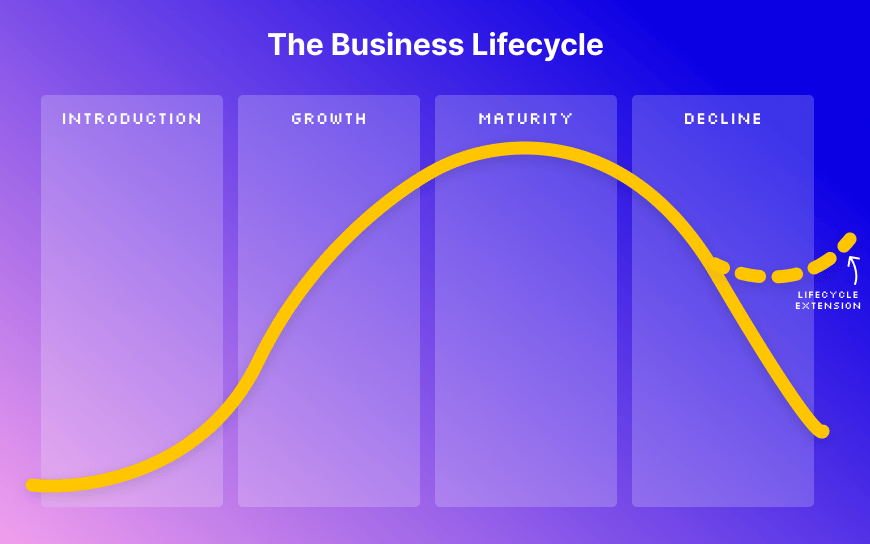
If you’ve ever worked for a corporate and been fed up about how slow they are – or worked at a startup that seemed to dismiss useful systems and processes – then you’ve been a victim of the Business Lifecycle.
The Business Lifecycle is basically the stages all companies go through: introduction, growth, maturity, and decline. Being able to pinpoint where you are on this curve can give you a shortcut into understanding weird decisions and priorities. You can also use it to figure out where you thrive (and where you don’t) when looking for new job opportunities.
Today, we’re going to explore the Lifecycle and each of the stages – what the stage is all about, what’s a focus and what’s not, and also what it’s probably like to experience it as an employee.

The business lifecycle

The business lifecycle: introduction, growth, maturity, and decline
These are the four stages of the business lifecycle – introduction, growth, maturity, and decline. (Some companies will also see a lifecycle expansion, which delays the decline.)
For smaller companies, your entire business will be in one of these segments, but big companies might actually span a couple. If you take a big bank, for example, the majority is probably in “Mature,” but if they have a neobank arm that actually might be in “Introduction.” But for the sake of simplicity today, I’m just going to assume that your company is only in a single stage!
👋 Introduction stage
This is typically your pre-seed, really tiny startup stage. The focus here is all about getting to product-market fit before the business dies.
👍 Businesses in Introduction stage will care about:
Rapid, rapid iteration and validation with customers
Customer acquisition
Cashflow (and sometimes, raising)
👎 Businesses in Introduction stage typically will not care about:
Retention and deeper activation metrics
Formal processes, documentation, or systems
Structure or HR processes
💘 This stage could be a great fit for you if you:
Thrive in the unknown, love to experiment, and enjoy a rapid pace
Enjoy informal collaboration, or deep work on your own, rather than meetings or rituals
Crave high-growth opportunities and variety in your work
🙅♀️ This stage probably isn’t right for you if you:
Are really prioritising role stability and salary right now
Like business structures like proper reporting lines, career growth frameworks, annual compensation reviews, and planning
Struggle with chaos or constant pivots
🚀 Growth stage
This stage is about growing the business now that you know what works, and you typically have an influx in capital to work with, either from sales or investors. It’s basically when you’re at a scale-up. The main defining trait of this stage is growing pains: you’ll try to put more systems and processes in place and they will all break on a regular basis.
👍 Businesses in Growth stage will care about:
Hiring and org structures as roles get more defined
Processes for collaboration and ways of working
Scaling the tech infrastructure to keep up with load (since typically it’s neglected a lot in the Introduction stage)
👎 Businesses in Growth stage typically will not care about:
Planning too long-term (but you’ll start to see some shorter horizon planning)
Optimisation for efficiencies, processes, and polish
💘 This stage could be a great fit for you if you:
Love the chaos of the Introduction stage but want a bit more stability and structure
Have ambitions to be promoted in a shorter timeline
🙅♀️ This stage probably isn’t right for you if you:
Struggle with chaos or (somewhat) constant pivots
Struggle with constant iteration on everything (org structure, rituals, processes, etc)
🧘 Maturity stage
This stage is where a lot of corporate jobs will be found – the business has figured out how to make money and keep a sustainable customer base, so even if they’re growing in headcount it’s a lot more manageable. Being in the maturity stage means you now have something to lose – customers, reputation, and investor trust – so this is when you start to become a lot more risk-averse.
👍 Businesses in Maturity stage will care about:
Optimising and systematising processes or craft
Polish and quality improvements
👎 Businesses in Maturity stage typically will not care about:
Experimenting in public
Rapidly switching tracks, even if it’s to adjust for competitors
💘 This stage could be a great fit for you if you:
Thrive in larger teams where you have peers, systems, and guilds
Have a specialised craft focus (eg. design systems, content strategy) and want to spend time on high-quality and attention to detail
Want the stability and structure of proper HR, accounting, reporting lines, etc.
🙅♀️ This stage probably isn’t right for you if you:
Find slow-moving businesses a bit depressing or frustrating
Like a generalist role more than a specialist one
🕳 Decline stage
The Decline stage is typically about winding down the business. There’s potential for a lifecycle extension (eg. finding the right market to pivot into) or to sacrifice part of the business to grow another area, but generally this isn’t a fun stage for most people.
👍 Businesses in Decline stage will care about:
Cost-cutting: headcount, services, etc.
Finding new opportunities that would pivot back into Growth
Managing customers
👎 Businesses in Decline stage typically will not care about:
Growing their people or hiring
Improving the existing product incrementally
🚨 If you find yourself in this stage,
Consider whether you actually have the potential to influence the business into a lifecycle extension – and if so, there is potentially a great growth opportunity there. Otherwise,
Consider looking for a new job.


Wait, so… where are we??
So now that we know the stages of each business, we can actually use it! Here are a few reflection exercises you could do now:
Which stage is your company in right now? Does that change any of your expectations or concerns?
Which stage do you think sounds the most like where you’d want to be?
If those stages aren’t the same, is the mismatch something you can handle with adjusting expectations, or is it something you’d need to consider changing?


